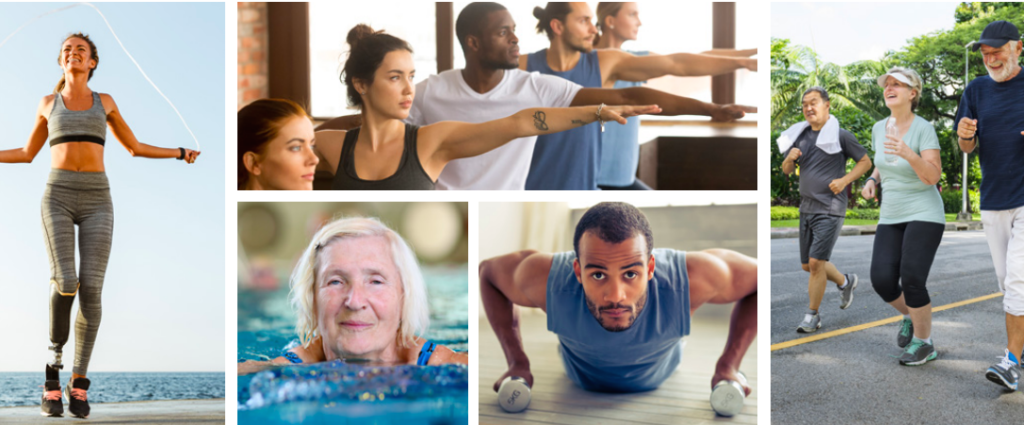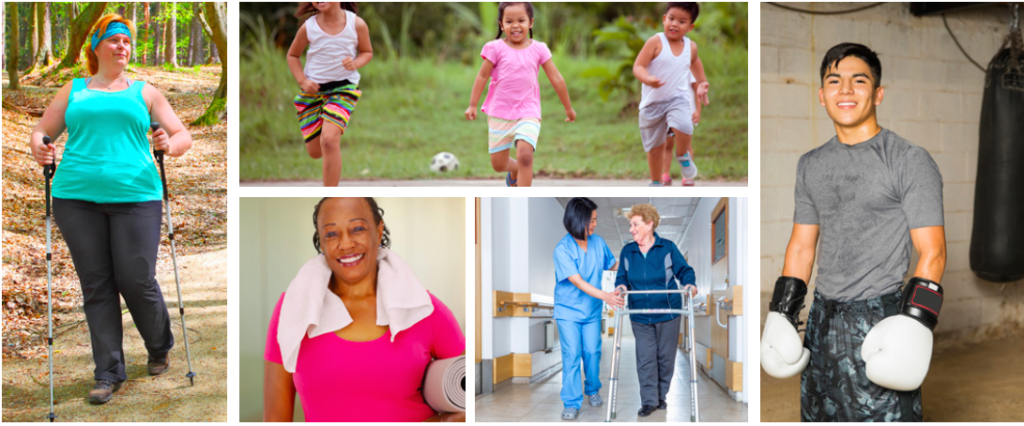Physical Activity Guidelines
- This article features excerpts from the Physical Activity Guidelines for Americans, 2nd edition. As written by U.S. Department of Health and Human Services
- –

MESSAGE FROM THE SECRETARY
Regular physical activity is one of the most important things people can do to improve their health. Moving more and sitting less have tremendous benefits for everyone, regardless of age, sex, race, ethnicity, or current fitness level. Individuals with a chronic disease or a disability benefit from regular physical activity, as do women who are pregnant. The scientific evidence continues to build—physical activity is linked with even more positive health outcomes than we previously thought. And, even better, benefits can start accumulating with small amounts of, and immediately after doing, physical activity.
Today, about half of all American adults—117 million people—have one or more preventable chronic diseases. Seven of the ten most common chronic diseases are favorably influenced by regular physical activity. Yet nearly 80 percent of adults are not meeting the key guidelines for both aerobic and muscle-strengthening activity, while only about half meet the key guidelines for aerobic physical activity. This lack of physical activity is linked to approximately $117 billion in annual health care costs and about 10 percent of premature mortality.
This new edition of the Physical Activity Guidelines for Americans has the potential to change that situation. It is grounded in the most current scientific evidence and informed by the recommendations of the 2018 Physical Activity Guidelines Advisory Committee. This Federal advisory committee, which was composed of prestigious researchers in the fields of physical activity, health, and medicine, conducted a multifaceted, robust analysis
of the available scientific literature. Their work culminated in the 2018 Physical Activity Guidelines Advisory Committee Scientific Report, which provided recommendations to the Federal Government on physical activity, sedentary behavior, and health. Informed by this Scientific Report and by public and Federal agency comments, the new edition provides guidance on the amounts and types of physical activity necessary to maintain or improve overall health and reduce the risk of, or even prevent, chronic disease.
The Physical Activity Guidelines for Americans is an essential resource for health professionals and policymakers as they design and implement physical activity programs, policies, and promotion initiatives. It provides information that helps Americans make healthy choices for themselves and their families, and discusses evidence-based, community-level interventions that can make being physically active the easy choice in all the places where people live, learn, work, and play.
Progress to reverse the high rates of inactivity-related chronic diseases and low rates of physical activity will require comprehensive and coordinated strategies. The Physical Activity Guidelines is an important part of a complex and integrated solution to promote health and to reduce the burden of chronic disease in our country. We all have a role to play in this critical effort. I invite you to join me in helping our country be more physically active. If we all move more and sit less today and work toward meeting the Physical Activity Guidelines ourselves, we will be well on our way to creating a healthier Nation and ensuring everyone can live healthier and more active lives.
Alex M. Azar II
Secretary
U.S. Department of Health and Human Services

Physical Activity Guidelines for Americans Summary
Being physically active is one of the most important actions that people of all ages can take to improve their health. The evidence reviewed for this second edition of the Physical Activity Guidelines for Americans is clear—physical activity fosters normal growth and development and can make people feel better, function better, sleep better, and reduce the risk of a large number of chronic diseases. Health benefits start immediately after exercising, and even short episodes of physical activity are beneficial. Even better, research shows that just about everyone gains benefits: men and women of all races and ethnicities, young children to older adults, women who are pregnant or postpartum (first year after delivery), people living with a chronic condition or a disability, and people who want to reduce their risk of chronic disease. The evidence about the health benefits of regular physical activity is well established, and research continues to provide insight into what works to get people moving, both at the individual and community level. Achieving the benefits of physical activity depends on our personal efforts to increase activity in ourselves, family, friends, patients, and colleagues. Action is also required at the school, workplace, and community levels.
Developing Physical Activity Guidelines
The Physical Activity Guidelines for Americans is issued by the U.S. Department of Health and Human Services (HHS). It complements the Dietary Guidelines for Americans, a joint effort of HHS and the U.S. Department of Agriculture (USDA). Together, the two documents provide guidance for the public on the importance of being physically active and eating a healthy diet to promote good health and reduce the risk of chronic diseases.
The primary audience for the Physical Activity Guidelines for Americans is policy makers and health professionals, though it may also be useful to interested members of the public. The main idea behind the Guidelines is that regular physical activity over months and years can produce long-term health benefits. The development of this edition of the Physical Activity Guidelines for Americans started in 2016 when former HHS Secretary Sylvia Mathews Burwell appointed an external scientific advisory committee, the 2018 Physical Activity Guidelines Advisory Committee. The Committee conducted a series of systematic reviews of the scientific literature on physical activity and health and met periodically in public session to discuss their findings. The Committee’s work was compiled into a scientific report summarizing the current evidence. The 2018 Physical Activity Guidelines Advisory Committee Scientific Report and summaries of the Committee’s meetings are available at https://www.health.gov/PAGuidelines/. When writing the Guidelines, HHS used the Advisory Committee’s Scientific Report as its primary source but also considered comments from the public and government agencies. The Guidelines will be widely promoted through various communications strategies online and in print, such as the Move Your Way campaign materials for professionals and consumers, and partnerships with organizations that promote physical activity.

Key Guidelines
Key Guidelines for Adults
Adults should move more and sit less throughout the day. Some physical activity is better than none. Adults who sit less and do any amount of moderate-to-vigorous physical activity gain some health benefits.
• For substantial health benefits, adults should do at least 150 minutes (2 hours and 30 minutes) to 300 minutes (5 hours) a week of moderate-intensity, or 75 minutes (1 hour and 15 minutes) to 150 minutes (2 hours and 30 minutes) a week of vigorous-intensity aerobic physical activity, or an equivalent combination of moderate- and vigorous-intensity aerobic activity. Preferably, aerobic activity should be spread throughout the week.
• Additional health benefits are gained by engaging in physical activity beyond the equivalent of 300 minutes (5 hours) of moderate-intensity physical activity a week.
• Adults should also do muscle-strengthening activities of moderate or greater intensity and that involve all major muscle groups on 2 or more days a week, as these activities provide additional health benefits.
Key Guidelines for Older Adults
The key guidelines for adults also apply to older adults. In addition, the following key guidelines are just for older adults:
• As part of their weekly physical activity, older adults should do multicomponent physical activity that includes balance training as well as aerobic and muscle-strengthening activities.
• Older adults should determine their level of effort for physical activity relative to their level of fitness.
• Older adults with chronic conditions should understand whether and how their conditions affect their ability to do regular physical activity safely.
• When older adults cannot do 150 minutes of moderate-intensity aerobic activity a week because of chronic conditions, they should be as physically active as their abilities and conditions allow.
Key Guidelines for Adults With Chronic Health Conditions and Adults With Disabilities
Adults with chronic conditions or disabilities, who are able, should do at least 150 minutes (2 hours and 30 minutes) to 300 minutes (5 hours) a week of moderate-intensity, or 75 minutes (1 hour and 15 minutes) to 150 minutes (2 hours and 30 minutes) a week of vigorous-intensity aerobic physical activity, or an equivalent combination of moderate- and vigorous-intensity aerobic activity. Preferably, aerobic activity should be spread throughout the week.
• Adults with chronic conditions or disabilities, who are able, should also do muscle-strengthening activities of moderate or greater intensity and that involve all major muscle groups on 2 or more days a week, as these activities provide additional health benefits.
• When adults with chronic conditions or disabilities are not able to meet the above key guidelines, they should engage in regular physical activity according to their abilities and should avoid inactivity.
Adults with chronic conditions or symptoms should be under the care of a health care provider. People with chronic conditions can consult a health care professional or physical activity specialist about the types and amounts of activity appropriate for their abilities and chronic conditions.
Key Guidelines for Safe Physical Activity
To do physical activity safely and reduce risk of injuries and other adverse events, people should:
• Understand the risks, yet be confident that physical activity can be safe for almost everyone.
• Choose types of physical activity that are appropriate for their current fitness level and health goals, because some activities are safer than others.
• Increase physical activity gradually over time to meet key guidelines or health goals. Inactive people should “start low and go slow” by starting with lower intensity activities and gradually increasing how often and how long activities are done.
• Protect themselves by using appropriate gear and sports equipment, choosing safe environments, following rules and policies, and making sensible choices about when, where, and how to be active.
• Be under the care of a health care provider if they have chronic conditions or symptoms. People with chronic conditions and symptoms can consult a health care professional or physical activity specialist about the types and amounts of activity appropriate for them.

To continue reading please click on the link below. It will take you to the pdf format of the “Physical Activity Guidelines for Americans 2nd edition“
What do you think about this article? I would love for you to share your thoughts in the Comment and Reply section below. Please write – I would love to read your thoughts!






Leave Your Comment